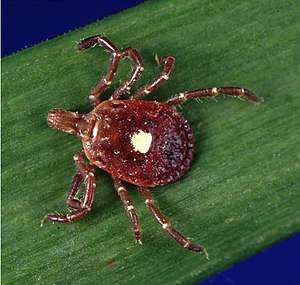Parasitiformes
Parasitiformes is an order[1][2][3][4] of Acari (treated as a suborder and superorder[5][6] in outdated classifications). An alternative name is Anactinotrichida.[7] Parasitiformes is one of two groups (orders) in Acari, the other being Acariformes (Actinotrichida).[8]
| Parasitiformes | |
|---|---|
.jpg) | |
| A tick of the species Ixodes ricinus | |
| Scientific classification | |
| Kingdom: | Animalia |
| Phylum: | Arthropoda |
| Subphylum: | Chelicerata |
| Class: | Arachnida |
| Subclass: | Acari |
| Superorder: | Parasitiformes Leach, 1815 |
| Orders and main families | |
| |
Description
Many species are parasitic (most famous of which are ticks), but not all. For example, about half of the 10,000 known species in the suborder Mesostigmata are predatory and cryptozoan, living in soil-litter, rotting wood, dung, carrion, nests or house dust. A few species have switched to grazing on fungi or ingesting spores or pollen.
The phytoseiid mites, which account for about 15% of all described Mesostigmata are used with great success for biological control.
There are over 12,000 described species of Parasitiformes, and the total estimate is between 100,000 and 200,000 species.
References
- Barker, S.C.; Murrell, A. (2004). "Systematics and evolution of ticks with a list of valid genus and species names". Parasitology. 129 (7): S15–S36. doi:10.1017/S0031182004005207. PMID 15938503.
- Evolution of ticks. Klompen, J.S.; Black, W.C.; Keirans, J.E.; Oliver, J.H. Annual Review of Entomology, 1996, Vol.41, pp.141-61
- John F Anderson, The natural history of ticks, Medical Clinics of North America, Volume 86, Issue 2, March 2002, Pages 205-218
- Hans Klompen, Mariam Lekveishvili, William C. Black IV, Phylogeny of parasitiform mites (Acari) based on rRNA, Molecular Phylogenetics and Evolution, Volume 43, Issue 3, June 2007, Pages 936-951
- Lindquist, E.E.; Walter, D.E.; Krantz, G.W. (2009) A manual of Acarology, 3 Edit. Lubbock: Texas Tech, pp. 97-103
- Schweizer, J. (1949). Die Landmilben des schweizerischen Nationalparks: Teil 1. Liestal: Lüdin.
- "Learn more about Parasitiformes". ScienceDirect. Retrieved 11 October 2017.
- Encyclopedia of Entomology - Volume 4 - Page 2414
